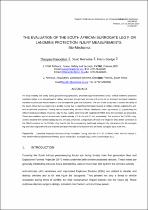 ResearchSpace
ResearchSpace
Evaluation of the South African surrogate leg for landmine protection injury measurements
JavaScript is disabled for your browser. Some features of this site may not work without it.
- ResearchSpace
- →
- Research Publications/Outputs
- →
- Conference Publications
- →
- View Item
| dc.contributor.author |
Pandelani, Thanyani A

|
|
| dc.contributor.author |
Reinecke, John D

|
|
| dc.contributor.author |
Beetge, F

|
|
| dc.date.accessioned | 2010-11-17T14:18:57Z | |
| dc.date.available | 2010-11-17T14:18:57Z | |
| dc.date.issued | 2010-01 | |
| dc.identifier.citation | Pandelani, T.A., Reinecke, D., and Beetge, F. 2010. Evaluation of the South African surrogate leg for landmine protection injury measurements. 7th South African Conference on Computational and Applied Mechanics (SACAM10), Pretoria, University of Pretoria, 10–13 January 2010, pp 11 | en |
| dc.identifier.uri | http://hdl.handle.net/10204/4567 | |
| dc.description | 7th South African Conference on Computational and Applied Mechanics (SACAM10), Pretoria, University of Pretoria, 10–13 January 2010 | en |
| dc.description.abstract | For troop mobility and safety during peacekeeping operations, protection against landmines is key. Vehicle landmine protection validation testing is an integral part of military equipment procurement process and serves as an important technical evaluation baseline for protected vehicle research and development goals and outcomes. The aim of this study was to assess the ability of the South Africa (SA) surrogate leg to predict injuries due to rapid floor/ foot plate impacts in military vehicles subjected to anti- vehicle landmine explosions. Testing was conducted using the South African developed Lower Leg Impactor (LLI) generating five different loading conditions. However, only the two loading conditions with established PMHS force-time corridors are presented. These two conditions are for impacts with a peak velocity of 3.4 m/s and 5.7 m/s respectively. The results of the THOR-Lx leg, used to establish the correct loading regime, are also presented. Comparisons of force-time response show better correlation to the PMHS corridors for the THOR-Lx leg than for the SA surrogate leg. Additional testing to fully characterize the SA surrogate leg and future improvements are required and recommended if the objective of a bio-fidelic surrogate leg is to be met. | en |
| dc.language.iso | en | en |
| dc.publisher | South African Conference on Computational and Applied Mechanics (SACAM) | en |
| dc.relation.ispartofseries | Conference Paper | en |
| dc.subject | Landmine protected vehicles | en |
| dc.subject | Validation testing | en |
| dc.subject | Post mortem human specimens | en |
| dc.subject | South African surrogate leg | en |
| dc.subject | Lower limb impactor | en |
| dc.subject | SACAM 2010 | en |
| dc.title | Evaluation of the South African surrogate leg for landmine protection injury measurements | en |
| dc.type | Conference Presentation | en |
| dc.identifier.apacitation | Pandelani, T. A., Reinecke, J. D., & Beetge, F. (2010). Evaluation of the South African surrogate leg for landmine protection injury measurements. South African Conference on Computational and Applied Mechanics (SACAM). http://hdl.handle.net/10204/4567 | en_ZA |
| dc.identifier.chicagocitation | Pandelani, Thanyani A, John D Reinecke, and F Beetge. "Evaluation of the South African surrogate leg for landmine protection injury measurements." (2010): http://hdl.handle.net/10204/4567 | en_ZA |
| dc.identifier.vancouvercitation | Pandelani TA, Reinecke JD, Beetge F, Evaluation of the South African surrogate leg for landmine protection injury measurements; South African Conference on Computational and Applied Mechanics (SACAM); 2010. http://hdl.handle.net/10204/4567 . | en_ZA |
| dc.identifier.ris | TY - Conference Presentation AU - Pandelani, Thanyani A AU - Reinecke, John D AU - Beetge, F AB - For troop mobility and safety during peacekeeping operations, protection against landmines is key. Vehicle landmine protection validation testing is an integral part of military equipment procurement process and serves as an important technical evaluation baseline for protected vehicle research and development goals and outcomes. The aim of this study was to assess the ability of the South Africa (SA) surrogate leg to predict injuries due to rapid floor/ foot plate impacts in military vehicles subjected to anti- vehicle landmine explosions. Testing was conducted using the South African developed Lower Leg Impactor (LLI) generating five different loading conditions. However, only the two loading conditions with established PMHS force-time corridors are presented. These two conditions are for impacts with a peak velocity of 3.4 m/s and 5.7 m/s respectively. The results of the THOR-Lx leg, used to establish the correct loading regime, are also presented. Comparisons of force-time response show better correlation to the PMHS corridors for the THOR-Lx leg than for the SA surrogate leg. Additional testing to fully characterize the SA surrogate leg and future improvements are required and recommended if the objective of a bio-fidelic surrogate leg is to be met. DA - 2010-01 DB - ResearchSpace DP - CSIR KW - Landmine protected vehicles KW - Validation testing KW - Post mortem human specimens KW - South African surrogate leg KW - Lower limb impactor KW - SACAM 2010 LK - https://researchspace.csir.co.za PY - 2010 T1 - Evaluation of the South African surrogate leg for landmine protection injury measurements TI - Evaluation of the South African surrogate leg for landmine protection injury measurements UR - http://hdl.handle.net/10204/4567 ER - | en_ZA |





